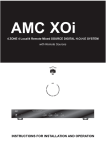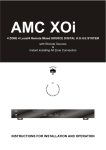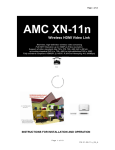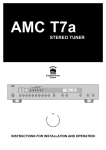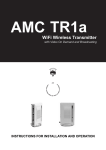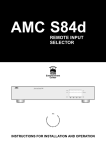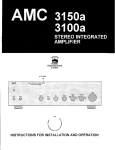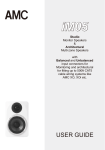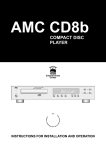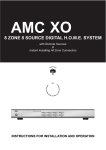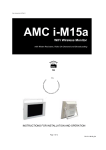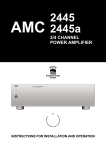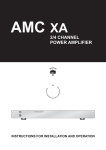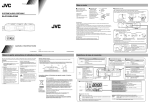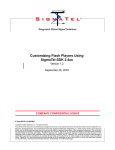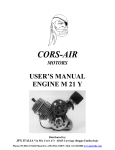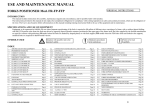Download AMC XT User Manual
Transcript
STEREO TUNER IA DAB APPLICATION AND FEATURE LIST Features of the AMC model XT * The AMC model XT tuner is designed to meet professional quality standards for reception of AM and FM broadcasts. * Select grade components are utilized throughout the circuit design with special emphasis on components within the audio path to assure stable, consistent performance and superb sound quality. * Quartz referenced phase locked loop (PLL) circuitry assures precise tuning. * Sophisticated surface acoustic wave (SAW) filter at antenna input guards against interference and noise. * Specially selected linear phase IF filters combined with other matched circuit components contribute to the ultra low distortion and excellent stereo separation. * A total of 30 AM and FM stations in any combination may be stored for recall. The preset memory is nonvolatile and will retain stored entries for more than two weeks in the event of power loss. * A MONO mode is provided to minimize background noise when listening to weak stations. * Built-in RDS function: Provides automatic reception and display of data provided by stations utilizing the Radio Data System (RDS) in their broadcasts (RBDS in USA). * DAB ready for future up-gradation. 2 REAR PANEL CONNECTIONS/FRONT PANEL CONTROLS REAR PANEL 2 8 3 7 6 4 1. RECEPTACLE & FUSE (T1AL 250V) 2. FM ANTENNA TERMINAL 3. AM ANTENNA TERMINAL 4. RS232 5. IR IN & IR OUT 5 9 1 6. ZONE 7. REGION 8. OUTPUT JACKS 9. TRIGGER FRONT PANEL 8 9 10 11 DAB 1 2 3 1. POWER SWITCH AND POWER INDICATOR 2. STATION PRESET 3. MEMORY 4. AM/FM 5. MONO 4 5 6. AUTO 7. TUNING 8. TEXT 9. TIME 10. PROGRAM 11. TYPE 3 6 7 REAR PANEL CONNECTIONS 1. AC RECEPTACLE The AC RECEPTACLE is for you to plug in with power cord attached in the packing or you can plug in with other power cord with your preferences. IR signal from rooms or IR OUT of other units can be connected the 3.5mm mini IR IN jack on the rear panel of XT. So, XT can be controlled by the IR remote control in each room through IR sensor. There is IR OUT as buffered output of IR IN for controlling units hooking up to XT or operating as daisy chain for the IR signal passing through the system. 2. FM ANTENNA TERMINAL An antenna must be connected to the XT for effective reception of FM broadcasts. A ribbon wire "folded dipole" antenna, which looks like a "T" when stretched out, is included to get you started. For best results, the crossbar portion of the "T" should be stretched out horizontally and attached to the wall, to the back of a cabinet or on the floor. The "Vertical" part of the "T" should be connected to the 75 Ohm FM antenna input on the rear panel o f the t u n e r b y u s i n g t h e 7 5 O h m matching transformer which is included in the accessory package. For additional information on antenna options, refer to "Notes On Antennas" section at the end of this manual. 6. ZONE 1 2 3 4 SWITCH You can select different remote command c o d e s t o c o n t r o l u p t o f o u r XTs independently with the same wireless remote control system. Set the Zone switch to the number 1-4 that corresponds to the zone you programmed with the remote control handset (see Remote Control). When you turn on the XT after you move the Zone switch the display will briefly flash ZONE CHANGE with the zone number you just selected. Notes: - The factory setting for the Zone switch and remote handset are 1. - The Zone switch should only be changed when the XT is turned off. 3. AM ANTENNA TERMINALS A single wire is supplied as an AM antenna. Connect it to the AM antenna terminal and position it for best AM reception by inserting one lead into the terminal marked "AM" and leaving the other lead unconnected. For additional information on antenna options, refer to the "Notes on Antennas" section at the end of this manual. 7. REGION SWITCH Set the switch for the region where you live. Tuning increments in the USA position (North America) are 200KHz for FM and 10KHz for AM. Turing increments in the EU position (Europe, UK, Scandinavia) are 50KHz for FM and 9KHz for AM. 4. RS232 CONNECTOR XT can be hooked to a control system through the RS232 connector. The XT can be hooked up to USB Hub or Ethernet Switch through RS232 to USB or RS232 to Ethernet adaptor. Through the RS232 connector, the XT can accept commands from your system controller and feed back status to be displayed. For details of RS232 commands, refer to the appendix I enclosed. 8. OUTPUT JACKS Connect standard audio cables from the L and R output jacks to the Tuner input on your preamplifier or system controller. You may connect the XT to any line-level input, even if the input isn't label "tuner". 9. TRIGGER For convenience the XT can be triggered to turn on automatically when a suitable voltage is applied to its Trigger IN jack. When automatic turn on is selected the 5. IR IN & IR OUT 4 XT front panel Power button is disabled so that on/off is determined solely by the triggering preamp or controller. Man Position When the Man Auto switch is in its Man (manual) position, the auto turn on function is disabled and the XT must be turned on and off manually with the Power button on its front panel. AUTO Position When the Man Auto switch is set to its Auto position, the XT is turned on and off with either an external dc or ac voltage of 3.3V to 30V from your controller or preamplifier. When external voltage ceases the XT will turn off immediately. The Auto switch position disables the front panel Power button. IN (3-30V AC/DC) The XT 3-30V AC/DC input uses a 2.5mm dc jack. To trigger the XT, plug one end of the cord into this jack and the other end into the source component's trigger output. Some components may use a 3.5mm trigger output jack, so you may have to use a 3.5mm jack to 2.5mm plug adaptor. OUT (12VDC) The 12Vdc trigger loop jack lets you "daisy-chain" the incoming trigger voltage to an additional XT or other component. 5 FRONT PANEL CONTROLS stations have been entered. f. If you change your mind or make a mistake, it is not necessary to reprogram all presets in sequence. Reprogram any preset simply by tuning to the desired station, press the MEMORY button and then press the desired preset number. g. If the MEMORY button is pressed by accident, it can be deactivated immediately by pressing again the MEMORY or AM FM button or simply by waiting 3 to 5 seconds for automatic deactivation. 1. POWER SWITCH When the power switch is pressed, the XT turns on and the small indicator light above the switch will glow blue. Press the switch again to turn off the XT and the indicator light goes out. 2. STATION PRESETS Any combination of AM and FM stations, up to a total of thirty selections, may be stored in the memory of the tuner. Each selection is assigned to a preset button and may be recalled by pressing the appropriate preset button. The memory will preserve preset assignments permanently after a power loss or if the AC line cord is unplugged. 4. AM FM This button switches between the two tuning bands: FM or AM. The digital tuning display shows the tuned frequency in MHz (for FM) or KHz (for AM). The tuning circuit maintains a "last station selected" memory, returning to the previously selected station when switching between bands. 3. MEMORY This button engages the Memory Enter mode which is used to assign selected stations to the presets. Procedure for entering stations into memory: a. Select either the FM or AM band by pressing theAMFM button. b. Manually tune to the desired station by using the Tuning Control buttons. Check the center tune indicator to be sure that the station is properly tuned and adjust if necessary. c. To store the selected station in preset number 1, press the MEMORY button, then press the 0 button and then the 1 button. (For preset positions 1 through 9, the 0 button should be pressed before the number is pressed, i.e. 01, 02, 03, etc. Otherwise, you may have to wait for few seconds after the 1 to 9 digit is pressed.) NOTE: After the MEMORY button is pressed, a preset position must be selected within approximately 5 seconds. If no preset position is selected within that time, the Memory Enter mode will automatically deactivate. d. After tuning to the next desired station, press the MEMORY button then, within 5 seconds, press the 0 button and the 2 button to store that station in preset position 2. e. Continue in this manner till all selected 5. MONO When a stereo FM signal is detected, the tuner automatically switches into stereo mode and displays the "S". However, very weak FM station signals may be excessively noisy. Pressing the MONO button disables the stereo FM circuits in the tuner resulting in significant reduction of noise. The "ML" is displayed when enforced mono operation is engaged. Remember to disengage the MONO button when tuning to normal stronger stations because as long as the MONO button is engaged, broadcasts cannot be received in stereo. 6. AUTO This button engages the AUTO mode, indicated by "(A)" on the left of the display. When in AUTO mode, the tuner advances in a station-by-station mode. When the Tuning buttons are pressed, the tuner will advance rapidly up or down automatically stopping at the next station whose signal is strong enough to assure good reception. A muting circuit automatically silences the output during the advance till the tuning circuits lock 6 When the TYPE button is pressed, the type of program material will be displayed, e.g. News, Classic, Pop, Sport, etc. If the selected station is not transmitting TYPE information, NONE will appear in the display. onto a station. Disengaging the AUTO button puts the tuner into MANUAL mode which allows tuning in small steps to search for weak stations or fine tuning to minimize interference. The MANUAL mode partially overrides the scan muting allowing all stations and interstation noise to be heard at reduced levels while tuning. When MANUAL mode is operating, "(M)" is indicated in the display. NOTE: TIME, TEXT, PROGRAM and TYPE are RDS functions. For the areas or the radio stations do not have RDS broadcasting, the display may not show any significant information. 7. TUNING Tuning up or down the AM and FM bands is accomplished by pressing either of the two TUNING buttons. Press the > button to tune toward higher frequencies or the < button to tune toward lower frequencies. When the XT is in MANUAL mode, the tuning frequency will change in small steps. When the XT is in AUTO mode, the frequency will continue to advance rapidly till the button is released. Observe the Tuning indicators while finetuning to obtain maximum signal strength. On FM, finetune till the centertune indicator is illuminated. 8. TEXT When the TEXT button is pressed, a text message will repeatedly scroll through the display. If the selected station is not transmitting a text message, NO TEXT will appear in the display. 9. TIME When the TIME button is pressed, the time is displayed. The first two characters at the left of the display indicate AM or PM followed by the time. If the selected station is not transmitting a time signal, NO CLOCK will appear in the display. 10. PROGRAM When the PROGRAM button is pressed, the selected station name will appear in the display. If the selected station is not transmitting the station name, NO NAME will appear in the display. 11. TYPE 7 REMOTE CONTROL OFF ON 1 2 3 4 5 6 7 8 9 +10 0 AUX CD TUNER PLAY/PAUSE ZONE STOP FM/AM TRACK TUNE PHONO VOLUME AUTO PRESET MANUAL DIRECT RC-S1 An infrared (IR) remote control RC-S1 is provided for convenient operation of the XT. The remote control handset provides most of the similar control functions as the front panel. RC-S1 is AMC simplified delicate system remote controller. Not only it can control XT but also AMC preamplifiers/receivers and CD players. FM/AM Press this button to toggle between FM and AM frequency bands. AUTO Press this button to activate AUTO TUNE. MANUAL Press this button to activate MANUL TUNE. T h e r e m o t e c o n t r o l has a r a n g e o f approximately 20-25 feet (6-7.5 meters). Use only AAA alkaline batteries in the handset and insert them according to the + and - polarity markings in the battery compartment. TUNE > and TUNE < Tuning up or down the AM and FM bands is accomplished by pressing either of the two TUNE buttons. Press the > button to tune toward higher frequencies or the < button to tune toward lower frequencies. ON To turn XT on. OFF To turn XT off. 8 ZONE You c a n s e l e c t d i f f e r e n t r e m o t e command codes to control up to four XTs independently with the same wireless remote control system. Program the remote handset to the number 1-4 that corresponds to the Zone switch number on the XT. Note the remote handset will not operate the XT unless its zone number matches the Zone switch setting. The factory settings for the remote handset and the unit's Zone switch are 1. To set the remote zone code, press both the zone key and the key 1~4 which corresponds to the setting of the XT Zone switch. These keys must be pressed simultaneously for about 1.5 seconds. CD TUNER AUX PHONO These four buttons select which input signal (CD, TUNER, AUX and PHONO) is fed to the inputs of AMC preamplifier or receiver. When CD is pressed, the numbered keys (0-9 and 10) allow direct selection of desired track. VOLUME > and VOLUME < These two buttons are used for adjusting the overall loudness level of the sound. It has no effect on the level of the signals fed to the TAPE OUT jacks for tape recording. PLAY/ PAUSE For AMC CD players use, press this button to toggle between PLAY and PAUSE. 0 1 2 3 4 5 6 7 8 9 The numbered keys perform several functions when combined with PRESET, DIRECT and CD buttons. See below:- STOP For AMC CD players use, to stop CD while playing. PRESET W h e n t h i s b u t t o n i s p r e s s e d , the numbered keys can be for direct access to each stored preset station. Presets 1-9 are displayed as P01, P02, P03, and so on. To select station presets 10-30, press the tens place key first. For example, to select 26, first press key 2, then press key 6. TRACK > and TRACK < For AMC CD players use, to let you set the desired track for listening. DIRECT W h e n t h i s b u t t o n i s p r e s s e d , the numbered keys can select the broadcast frequency of the station you wish to receive. First press the DIRECT key, then the numbered keys corresponding to the station. In USA: to receive FM 103.7, press DIRECT, 1, 0, 3, 7, 0. IN Europe: to receive 103.75, press the DIRECT key, then press keys 1, 0, 3, 7, 5. Note if you enter an incomplete frequency, such as 1, 0, 3, 7 which is missing the final 0 or 5, there will be a short pause while the XT fills in the missing number and finds the station. 9 SPECIFICATIONS FMTUNER SECTION Input Sensitivity MONO 30 dBTHD+N.......................................11.3 dBf (1.0 uV/75 ohm) MONO 50 dB S/N................................................15 dBf (1.5 uV/75 ohm) STEREO 50 dB S/N.............................................37 dBf (20 uV/75 ohm) STEREO 60 dB S/N.............................................47 dBf (60 uV/75 ohm) Capture Ratio (45 and 65 dBf)...............................................................................<1.5 dB AM Rejection (45 and 65 dBf).................................................................................>60 dB SelectivityALTERNATE CHANNEL.........................................................................65 dB Image Rejection.......................................................................................................80 dB RF Intermodulation..................................................................................................60 dB IF Rejection..............................................................................................................90 dB Subcarrier Suppression (19 and 38 kHz)..................................................................60 dB THD at 100% Modulation MONO 1 kHz..................................................................0.08% 100 Hz-6 kHz....................................................................0.2% STEREO 1 kHz..................................................................0.08% 100 Hz-6 kHz....................................................................0.3% Signal/Noise Ratio MONO...........................................................................>78 dB (at 65 dNf, 1HFweighted) STEREO.......................................................................>74 dB Frequency Response 30 Hz-15 kHz................................................................+/0.5 dB Stereo Separation 1 kHz...............................................................................50 dB 30 Hz-10 kHz.......................................................................35 dB Output Level.........................................................................................................530mV AM TUNER SECTION Useable Sensitivity...................................................................................................10 uV Selectivity.................................................................................................................30 dB Image Rejection.......................................................................................................45 dB IF Rejection..............................................................................................................35 dB Signal/Noise Ratio (30%modulation, 50mV input)...................................................45 dB THD..........................................................................................................................0.5% Output Level..........................................................................................................125mV Dimensions ( W x H x D) ....................................................................... 430 x 82 x 300 mm Power consumption ................................................................................................. 15 W Weltronics Corp. reserved the right to improve its products at any time. Specifications are subject to change without notice. 10 NOTES ON ANTENNAS In most cases, the exceptional sensitivity of AMC tuner circuits results in achieving very good performance with only a ribbonwire dipole antenna. However there are limitations to a dipole. It is not effective at rejecting multipath distortion and other forms of FM interference and it cannot easily be oriented for optimizing its reception pattern. Other possible solutions, in order of increasing cost, include: 1. Indoor TV antenna (rabbitears) without extra coils or tuning switches * Will NOT improve the strength of weak signals. * Has solid metal tuned elements that can be rotated. * The two elements should be extended to a total length of 30 inches (75cm) and oriented horizontally or at a shallow angle less than 45 degrees upward. * The antenna connecting wire should be connected to the tuner 75 Ohm antenna terminal using the matching transformer included in the tuner accessory package. * After selecting a station, rotate the antenna for best reception. 2. Indoor TV antenna (rabbitears) with a tuning switch * Will NOT improve the strength of weak signals. * May reduce some types of FM interference, such as reflected multipath signals. 3. Electrically tuned indoor antenna * Will NOT improve the strength of weak signals. * May further reduce some types of FM interference, such as reflected multipath signals. 4. Outdoor antenna * Provides largest selection of stations and best reception with lowest noise and distortion. * Narrower directional pattern more effectively rejects reflected multipath signals. * Signal strength is directly proportional to the antenna height above the ground. * May be mounted to a tall mast or to a roof. * Because TV antennas are purposely designed to be weak at FM frequencies, to lessen interference to TV signals, a directional FM only antenna will provide best results. * FM only antenna should be mounted as high above ground as practical and at least two meters (7 feet), both horizontally and vertically away from other antennas. * Can be mounted on a rotor to allow aiming at stations located in different directions (more than 90 degrees apart). * Use shielded lead in wire rather than plain "twinlead" wire for better performance, longer life and protection from the weather. * Disconnect any indoor antenna from the tuner before connecting the outdoor antenna. CAUTIONS: * Avoid power lines when locating and installing antenna * Include a lightning arrestor in the installation to protect both yourself and the tuner from potential danger during electrical storms. OUTDOOR AM ANTENNA * To improve AM reception, a "longwire" outdoor AM antenna may be installed. * A "longwire" antenna is simply a straight wire which may vary in length from a few feet up to about 100 feet (30 meters). * Must be mounted parallel to the earth and should be located as high above the ground as convenient. * Connect to the tuner at the AM antenna terminal. * Connect another wire from the Ground terminal to a true "earth" ground, such as a copperplated rod driven several feet into the earth. Alternate grounds include a coldwater pipe, a steam radiator or even the third hole of a modern electrical wall socket. 11 SAFETY INSTRUCTION 16. DAMAGE REQUIRING SERVICE 1. READ INSTRUCTIONS All the safety and operating instructions should be read before the appliance is operated. 2. RETAIN INSTRUCTIONS The safety and operating instructions should be retained for future reference. 3. HEED WARNINGS All warnings on the appliance and in the operating instructions should be adhered to. 4. FOLLOW INSTRUCTIONS All operating and use instructions should be followed. The appliance should not be used near water - for example, near a bathtub, washbowl, kitchen sink, laundry tub, in a wet basement, or near a swimming pool, etc. 6. CARTS AND STANDS The appliance should be used only with a cart or stand that is recommended by the manufacturer. 7. WALL OR CEILING MOUNTING 17. POWER LINES (APPLIES TO TUNERAND RECEIVERS ONLY) An outdoor antenna should be located away from power lines. 5. WATER AND MOISTURE 6A. An appliance and cart combination should be moved with care. Quick stops, excessive force, and uneven surfaces may cause the appliance and cart combination to overturn. The appliance should be serviced by qualified service personnel when: a) The power-supply cord or the plug has been damaged; or b) Objects have fallen, or liquid has been spilled into the appliance; or c) The appliance has been exposed to rain; or d) The appliance does not appear to operate normally or exhibits a marked change in performance; or e) The appliance has been dropped, or the enclosure is damaged. PORTABLE CART WARNING S3125A This equipment is not designed for use mounted on a wall or a ceiling. 8. VENTILATION The appliance should be situated so that its location or position does not interfere with its proper ventilation. For example, the appliance should not be situated on a bed, sofa, rug, or similar surface that may block the ventilation openings, or placed in a built-in installation, such as bookcase or cabinet that may impede the flow of air through the ventilation openings. 9. HEAT The appliance should be situated away from heat sources such as radiators, heat registers, stoves, or other appliances (including amplifiers) that produce heat. 18. OUTDOOR ANTENNA GROUNDING (APPLIES TO TUNERAND RECEIVERS ONLY) If an outside antenna is connected to the receiver, be sure the antenna system is grounded so as to provide some protection against voltage surges and built up static charges. Section 810 of the National Electrical Code, ANSI/NFPANo. 70-1984, provides information with respect to proper grounding of the mast and supporting structure, grounding of the lead-in wire to an antenna discharge unit, size of grounding conductors, location of antenna-discharge unit, connection to grounding electrodes, and requirements for the grounding electrode. See Figure. a) Use No. 10 AWG (5.3 mm2) copper, No. 8 AWG (8.4 mm2) aluminum, No. 17 AWG (1.0 mm2) copper-clad steel or bronze wire, or larger, as a ground wire. b) Secure antenna lead-in and ground wires to house with stand-off insulators spaced from 4-6 feet (1.22-1.83 m) apart. c) Mount antenna discharge unit as close as possible towhere lead-in enters house. d) Use jumper wire not smaller than No.6 AWG (13.3 mm2) copper, or the equivalent, when a separate antennagrounding electrode is used. See NEC Section 810-21(j). Antenna Grounding According to the National Electrical Code 10. POWER SOURCES The appliance should be connected to a power supply only of the type described in the operating instructions or as marked on the appliance. Antenna Lead In Wire 11. POWER-CORD PROTECTION Power-supply cords should be routed so that they are not likely to be walked on or pinched by items placed upon or against them, paying particular attention to cords at plugs, convenience receptacles, and the point where they exit from the appliance 12. CLEANING The appliance should be cleaned only as recommended by the manufacturer. Ground Clamp Electric Service Equipment The power cord of the appliance should be unplugged from the outletwhen left unused for a long period of time. Power Service Grounding Electrode System (NEC Art 250 Part H) 14. OBJECT AND LIQUID ENTRY 15. SERVICING The user should not attempt to service the appliance beyond that described in the operating instructions. All other servicing should be referred to qualified service personnel. Grounding Conductors (NEC Section 810.21) Ground Clamps 13. NON USE PERIODS Care should be taken so that objects do not fall and liquids are not spilled into the enclosure through openings. Antenna Discharge Unit (NEC Section 810.20) National Electrical Code Available from Library, book stores, or National Fire Protection Association (Batterymarch Park, Quincy. MA 02269). AMC 21-3004 WELTRONICS CORP. LONDON/L.A. AMC Web: http://www.amchome.com PN: 21-2622
















